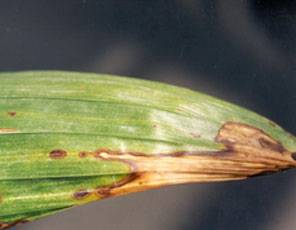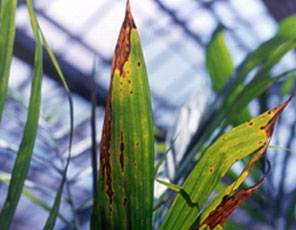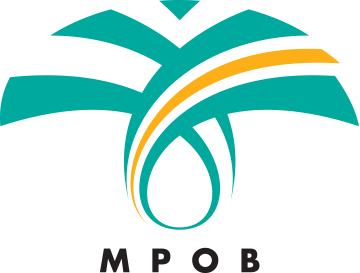Biology and Symptom
Prevalence to seedlings more than 3 years old particularly on the older leaves. Symptoms are varies depending on the causal pathogens causing large yellow brown circular or elongated spot which later can caused necrosis of the leaf. The mode of spread is primarily by spores, spread rapidly by rain and excessive watering of seedlings. Seedlings after three months of transplanting are most vulnerable, mainly due to 1. Overcrowding, 2. Excessive watering and 3. Over shade. Anthracnose infection is capable of destroying the whole nursery if left uncontrolled. Incidence of 5-20% is common due to transplanting shock.
Causal
Anthracnose is caused by three distinct fungi, namely Botryodiplodia palmarum, Melanconium spp. and Glomerella cingulata.
a) Botryodiplodia palmarum – Early symptom is shown by small translucent spots on leaves. Spots enlarge and change to dark brown followed by a pale brown halo surrounding them. The central region of the spot contains spores producing structure.

b) Melanconium – Infects leaves with similar symptoms as Botryodiplodia spp. Starts with appearance of small hyaline spots, later becoming light brown, like a water-soaked appearance. A pale-yellow margin later develops around the infected area.

c) Glomerella cingulata – Symptoms by Glomerella are quite distinct. The spots develop between the veins, later expanding into elongated streaks, bordered by pale yellow halo.
Disease Management and Control
Keep the disease incidence low by maintaining balanced nutrients in soil, adequate water supply and shading, minimal damage and shock during transplanting into nursery, avoid overcrowding the seedlings, avoid using peat as medium, remove infected seedlings immediately. Control at the early stage of infection by spraying fungicide such as 0.2% Thiram (80% a.i) or 0.5% captan (50% a.i), with the following requirements:
- Spray only when the foliage is dry.
- Spray with adjuvant, to avoid being washed off by rain.
- Spray weekly or every 10 days until all symptoms disappeared.
